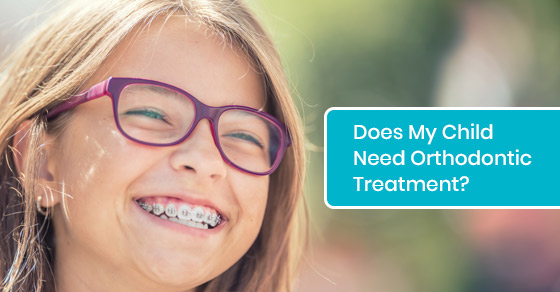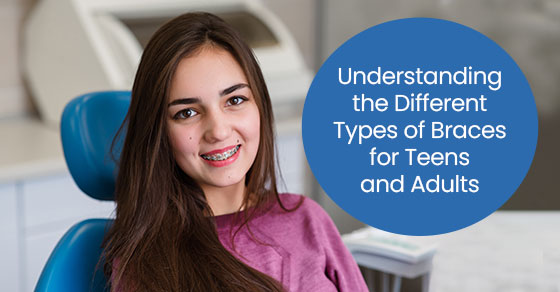The thought of orthodontic treatment can be a little unsettling for parents and kids alike. However, it is important to remember that orthodontic treatment addresses more than just straight teeth. Treatments are also designed to perfect a child’s bite so that their upper and lower teeth fit comfortably.
We keep an eye on your child’s teeth as they ago to determine if and when they need orthodontic treatments. Timing is always important for orthodontics as the goal is to target issues before they cause harm.
If you’re wondering if your child needs the orthodontics, here is all the information you need to spot potential issues early on.
The Progress of Your Child’s Teeth
Every child’s mouth is unique; however, there are generally some things you can expect to see. By age 6, your child’s first molars will start to appear. The problem with determining if a child will need orthodontics is that two-thirds of their teeth are hidden by their gums and the bone that holds them in place.
This makes it difficult to know how teeth will emerge. There are some clues to look for, including:
- If your child either loses their baby teeth either earlier or later than other children
- Your child has experienced trouble biting and chewing
- Your child breathes through their mouth
- Your child experiences difficulty speaking
Depending on the signs your child displays, they might require orthodontic treatment, even before they have all their permanent teeth. This is in cases where a child requires guidance as they continue to develop their jawbones to make room for their permanent teeth. This catches issues early on so that as your child’s teeth and jaw develop, everything comes together beautifully.
Age 7 is Key
Orthodontics focuses on improving a patient’s bite, and as mentioned above, timing is key to discovering potential issues as your child’s teeth and jaw develops. By the age of 7, a child will have signs that orthodontic treatment is required.
Why Braces are Required
There is no one reason kids need braces. While many parents think their child will only need braces if their teeth are “crooked,” orthodontics goes far beyond providing that perfect smile.
Many issues, including overlapping, overcrowding, and malocclusion — bite issues — can be corrected with orthodontics. Malocclusion occurs when there are differences between the size of the upper and lower jaw. This can include an overbite if the upper jaw is bigger than the lower jaw or an underbite if the upper jaw is bigger than the lower jaw.
Many causes can lead to orthodontic issues, including accidents, thumb or pacifier sucking, or losing baby teeth too soon. Most of the time, the need for braces is for hereditary reasons. The earlier issues are detected, the more successful the treatment.
Usually, issues will be spotted between the ages of 7 and 10; however, in some cases, a child might reach their teens before orthodontic treatment is recommended. Although your child might see an orthodontist earlier on, they might not be ready for treatment right away. Your child’s teeth and jaw are monitored to determine which device or treatment is required and what time will be optimum to begin.
What to Expect at Your First Orthodontist Visit
If your child does see an orthodontist — in Mississauga or anywhere else — they will have a thorough exam to check their teeth, mouth, and jaw.
The orthodontists will pay special attention to bite checking to see how their teeth fit together. They will also discuss difficulties your child might experience with speaking, chewing or swallowing. They will listen for clicking or popping sounds when your child chews or moves their jaw.
X-rays are usually taken to check the positioning of teeth and see how many permanent teeth are still waiting to erupt. Often an impression will be taken of your child’s teeth, and they will be asked to bite into dental trays filled with a soft material. We can study the impressions to help determine what treatment to recommend.
Type of Orthodontic Treatments
Following your child’s first appointment, there are a number of different treatments that might be recommended:
1. Interceptive orthodontics
Interceptive orthodontics provides a treatment plan to encourage proper development. By catching issues early on, we can ensure the teeth have a chance to come in without protrusions, overlaps, and bite issues.
This keeps the jaw healthy while providing space for all your child’s teeth to fit in their mouth perfectly. We will recommend interceptive orthodontics when your child has:
- Open, deep, crossbite
- Crowding
- Spacing
- An incorrect sequence of emerging teeth
- Missing teeth
- Ankylosed teeth
- Issues due to thumb sucking, pacifiers and tongue pushing
When we catch problems early on, your child will be less likely to require dental work in the future. Once your child’s permanent teeth erupt, the treatments become far more expensive, not to mention invasive.
2. Two-phase orthodontics
In the two-phase approach, your child begins treatment when they still have their baby teeth, and then treatment changes when their permanent teeth come in.
The first stage addresses proper bite or works to correct bad habits. Teeth can be guided into the best position if possible, which can often stop problems before they can develop.
The first phase also addresses the jawbone, which can support the jaw and allow teeth to grow properly, so everything is aligned. Once this treatment is complete, the second stage focuses on shifting permanent teeth into their final position for both appearance and functional purposes.
3. Traditional braces
Braces are used to correct alignment problems using pressure to ease teeth into the proper position. There are a few more options today for this type of orthodontic treatment, including traditional braces with brackets, wires, and rubber bands, clear or white ceramic braces, and even lingual braces, which are attached at the back of the teeth to make them less noticeable.
A popular option, especially for teens, is removable clear “aligners.” They fit over the teeth, much like mouthguards, but are far less noticeable. However, they are not effective for all orthodontic treatments.
In some cases, your child might need to have some teeth removed to allow the remaining teeth to grow in properly. Treatments usually last about 2 years, and retainers are required to keep teeth from returning to their original position.
To learn more about whether your child needs orthodontic treatment, call Bristol Dental at 905-712-3409 or contact us here.






[…] health problems for those who have them. For these reasons, it’s important to seek the correct orthodontic treatment based on the severity of the case, and correct a bite problem without […]